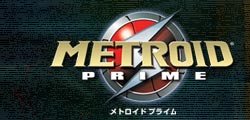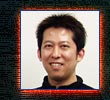 |

Before we begin, can the three of you please tell us your roles?
 Tanabe: With my work on Metroid Prime, I am overseeing production for a subsidiary of Nintendo, Retro Studios. My duty in this capacity is Co-Producer. Specifically, I work have the work of a supervisor to coordinate everybody, and I produce promotional items.
Tanabe: With my work on Metroid Prime, I am overseeing production for a subsidiary of Nintendo, Retro Studios. My duty in this capacity is Co-Producer. Specifically, I work have the work of a supervisor to coordinate everybody, and I produce promotional items.
Otani: My title is also the same as Tanabe-san's, but I have been mainly involved with production in the field.
Tanabe: American companies have a different system than Japanese companies, and they also don't often have people called directors. There are producers, and below them in the hierarchy are engineers and designers. Since there was also no director on location at Retro Studios who overlooked the entire project, he [Otani] was, of course, given the work of a director. Because this company is in Texas, we had to go there about five times.
Tabata: I translated documents exchanged between Retro Studios and Nintendo and translated texts.
To begin with, why was a Metroid game made for the Gamecube?
Tanabe: When Retro Studios said they were making a project for the Cube, Miyamoto suggested, "Why don't you try making Metroid?" Since Metroid is very popular in America, they of course loved [the idea]. Because of that, they began production.
The game is also unique in that it starts from the perspective of Samus.
 Tanabe: That's right. Since we were directed to create the game in first person perspective, in order to differentiate from other first-person perspective games, the visor system was created. We came up with that system so beginners could play a first-person game using one control stick.
Tanabe: That's right. Since we were directed to create the game in first person perspective, in order to differentiate from other first-person perspective games, the visor system was created. We came up with that system so beginners could play a first-person game using one control stick.
Does Samus have any new abilities?
Tanabe: We added a special ability called "Boost Ball" that allows you accelerate while in Morph Ball form. Since you can boost in Ball form, you can move to high places in curved terrain.
|


What was the thing you were most careful of for this work to be a hit?
Tanabe: Overseas games are good, but we had to be careful it would not become tasteless. Now that I think about it a little, we were very strict on that point.
Was that also why you had to translate detailed instructions, Tabata-san?
 Tabata: That's correct. I remember it was difficult because at the very beginning I couldn't understand at all any of the game's technical terms. Certain words are used in Japan, but they couldn't understand what I was talking about. I studied every day.
Tabata: That's correct. I remember it was difficult because at the very beginning I couldn't understand at all any of the game's technical terms. Certain words are used in Japan, but they couldn't understand what I was talking about. I studied every day.
Tanabe: The things she had to translate piled up; it looked like a mountain! On top of that, her work started as soon as we made written instructions. Because we were driven by a tight schedule, it really was difficult for her to translate promptly and accurately so we could convey our instructions to them.
Did you exchange e-mail overseas?
Tabata: Absolutely. Beyond that, I served as local coordinator and we went over about two times.
Tanabe: We also carried out countless video conferences. While they ran a demo on the computer screen, we exchanged messages back and forth. We communicated through NOA (Nintendo of America), and it was very difficult for Tabata-san because a three-way meeting was going on while we had her translate for us. Of course, since there were times when I wanted to point out "here on this screen," her work was absolutely necessary.
It must have been convenient to be able to direct while you were in Japan.
Otani: Of course, there were a lot of times I had to go on-site and talk to them directly.
Tanabe: He had to stay there for about two months during the final stages of development. They had to prepare him a room at Retro Studios.
Otani: Since I had to go so often, by the final stretch, I had grown accustomed to Amiercan food! (Laughs)
Did you become good at communicating?
Otani: Even though we were communicating face-to-face, since it took awhile for the oral translation to come through, it took time for us to gain a mutual understanding. Since we came from different cultures, we had different ways of thinking, so there were many times where once a meeting began, it would go on like that until early morning. In the end, we were communicating by gesturing with arms and legs. Aside from that, we also used storyboards as a method, and we would work with those directly in front of us. Gradually, the staff also saw me as a member of the team. It isn't uncommon for overseas staff, but they were willing to work overtime and on their days off. I think as a result of us tackling things so zealously, the result is an extremely good game.
So I guess rather than overseeing the whole project, you gave them very specific directions.
 Otani: That's right. Our team basically provides coordination for an external company, but we aren't closely involved in production. This time, we were much more closely involved. Actually, up until the design document was made, the cases were rare where I had to write something.
Otani: That's right. Our team basically provides coordination for an external company, but we aren't closely involved in production. This time, we were much more closely involved. Actually, up until the design document was made, the cases were rare where I had to write something.
Up until the design document! Even Metroid fans should understand if Nintendo supervised production very closely.
Otani: Actually, since the American release's reputation is very good, I think I didn't have to evaluate it.
The American and European versions came out first, but are there any differences with the Japanese version?
Tanabe: It's unusual in that the Japanese version is harder than the American version. The European and Japanese versions have the same level of difficulty and amount of resources. In addition, the Japanese version and European version have more kinds of items, and part of the cutscenes have been changed. Visual effects were added, and the animations were changed. Among these, there is one case with the Grappling Beam where the cutscene was changed entirely.
Fans have wanted to play both the American and Japanese versions. About how many hours will it take to play the game?
Tanabe: For first-time players, roughly 20~30 hours.
So that means it's a very big game. It looks very fun to play. Well, please give a final word for our readers.
Otani: First-person games are very difficult for Japanese players to accept, but we have made it so it is very easy even for beginners to play. Please enjoy this new form of first-person perspective game that is different from traditional first-person perspective games.
Tanabe: I think players will be acutely aware of the sense of loneliness of exploring a planet by oneself. Also, players might have the impression that foreign games are hard to control, but in this game, we were quite particular about ease of control, and there is also very high level of technical skill. Please going out and buy it.
Tabata: Personally, I haven't played many first-person perspective games. However, when I picked up and tested this one, it was very easy and fun to play. In any case, if you go and try it out, I think you'll find it is of high quality. Everyone, please pick it up and give it a try.
|

|
|
 |




















